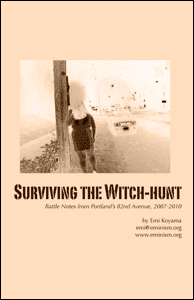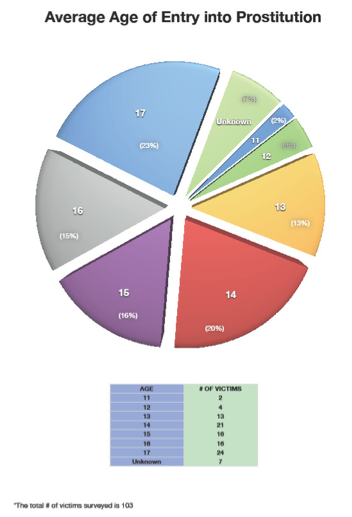This past week, someone from a national organization working to end violence against women contacted me and asked for my view about addressing the problem of sex trafficking on Craigslist. The inquiry is related to the Coalition Against Trafficking in Women’s planned protest at the headquarters of Craigslist, which is calling for Craigslist to prohibit classified ads for adult services. Below is an excerpt from my response.
*****
I think I already wrote my basic thoughts about this topic in the previous email, but here are some details:
1. Craigslist is not the problem. It appears to be doing whatever it can do to fight trafficking on its site, such as
- requiring confirmation by phone before an ad is posted–this ensures that whoever posted the ad can be tracked down if needed
- requiring payment by credit card, which provides further mechanism to track down
- manually reviewing every single ad that is posted for signs of trafficking or child sexual exploitation
- providing a directory of agencies to report suspected trafficking to
- cooperating with the law enforcement, providing them with tools and information needed for conducting investigations
2. There are many alternatives to Craigslist where sex workers and their pimps/managers/traffickers can advertise. Because Craigslist is a company that does business with the general public, it is in their best interest to work with non-profit organizations and law enforcement to combat trafficking in order to protect its public image. Operators of websites that specifically cater to the sex industry do not have the same incentive.
3. Adult service ads are a big part of Craigslist’s bottom line, as they are to alternative weeklies and other traditional media. But they do not necessarily depend on human trafficking. There is no evidence that human trafficking is a substantial problem at Craigslist, or any more of a problem than in any other media outlets (and Craigslist does more to address the problem of trafficking than any other classified services).
4. Many women use Craigslist to advertise their services because it is a relatively safe and cheap way to do so without a pimp, management, or large start-up cost (e.g. advertising in alternative newspapers). Cracking down on Craigslist harms many of these women by taking away opportunities for economic self-sufficiency and autonomy.
5. I did a LexisNexis research for reports about trafficking on Craigslist, and I found that vast majority of examples involved minors being recruited into prostitution. I’m trying to figure out how these pimps got caught, because that might give us an idea about how to identify sexual exploitation of minors, but there isn’t enough information in most newspaper articles.
That said, some incidences were uncovered because the ads hinted at trafficking (e.g. an ad offering “sex slave” for sale–which should never have passed Craigslist’s manual review and should have been reported immediately); while some others appear to have been intervened because the girl pictured in the ad looked too young.
I think that we should work with Craigslist to improve mechanisms to identify ads that share characteristics similar to other ads that have been identified as involving child sexual exploitation or trafficking. Craigslist is a technology company, and I’m sure that they can do better in this regard, utilising data mining technologies to distinguish between a woman posting an ad for herself or someone posting an ad on her behalf with her consent, versus someone forcing her to work. (Other industries such as banking and airlines use similar technologies to identify potentially fraudulent financial transactions or suspected terrorist activities.)
6. I also would like Craigslist to cooperate with projects such as Portland Bad Date Line, with which I am tangentially involved. Portland Bad Date Line collects reports about “bad dates,” that are johns who act violently or abusively, or announcing being HIV+ after insisting on and having unprotected sex, or pimps who chase the women in an effort to get the women to work for them, etc. and distribute this information to women (and others) working in the sex industry so that they can take further precautions.
Craigslist could post this sort of information for each region prominently in adult services section, which would provide information women can use to be safer while working, while at the same time warning potential “bad dates” that their information would be shared if they act out. Craigslist should also post information for women seeking help more prominently, although it is questionable whether or not women who are trafficked would actually see the site.
Let’s get Craigslist involved. I have other ideas that I want to bring up with Craigslist if we can get their ears.
7. I feel that what I’ve written above makes sense, and it is the rational and sensible approach to addressing the problem of trafficking. But I do not feel that many U.S.-based “anti-trafficking” groups are serious: they are simply using it as a cover to attack prostitution and the sex industry, and have little regard for how their actions might impact the people they are claiming to protect.
Case in point: the campaign to “end the demand” is absurd. Economics 101 suggests that if the demand for sexual services were to decrease, it would push the price of such services down. But supply is downwardly inelastic, since many women work in the sex industry because they do not have other viable economic opportunities, and the price has to go down quite a bit before another option–such as working as janitors and maids–become more viable compared to prostitution. That is, supply will not go down as much as demand does, and the end result is that more workers would be competing for fewer johns. It would not only mean less income for the women and their families, but it would also force women to make more risky choices–such as having unprotected sex.
Further, not all johns are equally predatory or unsafe to the women. Campaign to “end the demand” would mostly drive away johns who are risk-averse (i.e. those who do not like to take risks), while it would not affect thrill-seeking, risk-insensitive johns. But these thrill-seeking, risk-insensitive types are the ones that present more health and physical risks to those working in the sex industry. In other words, such campaign directly and indirectly harm the women working in the sex industry.
Here, the intentional conflation of trafficking and prostitution by the U.S. “anti-trafficking” movement constitutes a real problem: trafficking involves force, deception, or threats, which should be immediately intervened and victims rescued; advocating for the women working in the sex industry requires a much more nuanced and multi-faceted approach (such as creating viable economic opportunities and promoting economic and social justice). The campaigns to “end the demand” or to shut down Craigslist’s adult services section are most likely ineffective at actually addressing the issue of trafficking, and extremely harmful to the women who are working in the sex industry. And yet, by conflating the two, the U.S. “anti-trafficking” movement hijacks the discourse surrounding the sex industry, making it difficult for those of us working to advocate for women who are working in it.
Another example of irrationality: reports after reports claim that the average age of entry into prostitution is around age 13, usually citing Department of Justice or FBI as the source. If average is 13, that would suggest that there are equal number of 6-year olds and 20-year olds entering prostitution (assuming normal distribution), and that is obviously untrue. It is shocking to encounter someone who had become involved in prostitution at age 13 or younger, but this is definitely an exception, not the norm.
The “statistics” actually comes from a survey of minors who had an encounter with social services, and as such does not include any adults. If you only study minors who are in prostitution, of course the average age of entry is below 18–but it has nothing to do with the average age of entry in general. Consider this: if you only studied people who died as a minor, the average age of death would be something like 13–but that doesn’t mean that the average life expectancy is 13.
So is 13 the typical age of entry for those who became involved in prostitution as a minor? The answer is no. Because the research cuts off at age 18, someone who started at 13 has five times more chance to be included in the study compared to someone who barely started at 17, making the early starters five times more represented in the study. I don’t have access to the original data sets to figure out the actual average, but I suspect that it is closer to 17–and this is only the average for those who were involved as a minor.
The truth is that none of us know the actual average age of entry, but I feel that the U.S. “anti-trafficking” movement is cynically publicising the demonstrably false claim (“the average age of entry is 13″) in order to equate prostitution with trafficking of minors, distorting the public perception of the issue and harming many women who are impacted by the anti-prostitution measures they promote.
I would also add a historical observation: in the past, the U.S. “anti-trafficking” movement have come and gone along with the anti-immigration sentiment in the nation, as exemplified by the “white slavery” panic that coincided with the historical period between Chinese Exclusion Act and Alien and Sedition Acts. The “white slavery” panic did not improve lives of women (including many immigrant women) who were working in the sex industry, but instead functioned as a springboard for repressive policies that target marginalized communities. I fear that the current “anti-trafficking” fervour, coinciding perfectly with the heightened anti-immigration sentiment, is moving along the similar trajectory, and I hope that we can redirect the movement so that it can actually offer safety and freedom for victims without causing harms on others.



